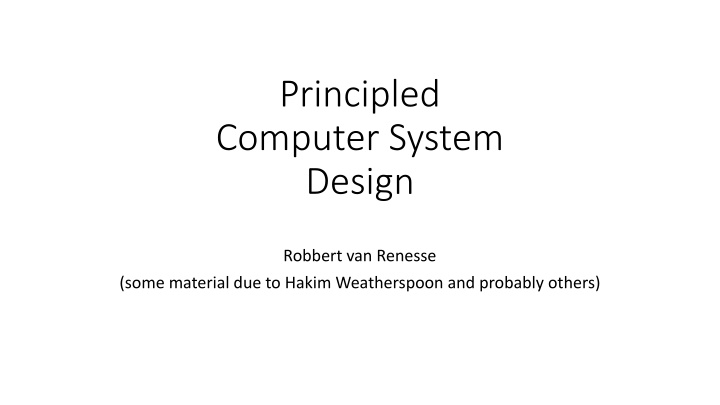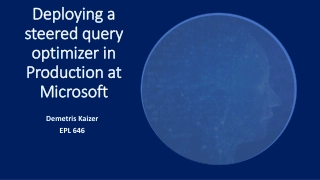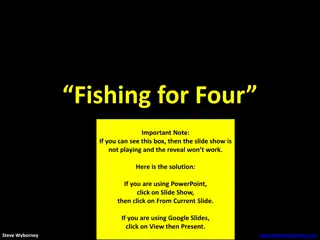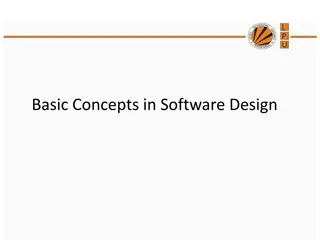
Insights into Computer System Design Fundamentals
Explore the art and science of system design through principles shared by Robbert van Renesse, Prof. Hakim Weatherspoon's exciting cloud project announcement, abstraction concepts, layering techniques, and valuable hints from Butler Lampson. Delve into the core elements of system design such as functionality, performance, assurance, and organization for effective problem-solving strategies in computer science.
Download Presentation

Please find below an Image/Link to download the presentation.
The content on the website is provided AS IS for your information and personal use only. It may not be sold, licensed, or shared on other websites without obtaining consent from the author. If you encounter any issues during the download, it is possible that the publisher has removed the file from their server.
You are allowed to download the files provided on this website for personal or commercial use, subject to the condition that they are used lawfully. All files are the property of their respective owners.
The content on the website is provided AS IS for your information and personal use only. It may not be sold, licensed, or shared on other websites without obtaining consent from the author.
E N D
Presentation Transcript
Principled Computer System Design Robbert van Renesse (some material due to Hakim Weatherspoon and probably others)
Message from Prof. Weatherspoon Please let the class know that they get their own cloud today! Mini Project0 is available, getting started on Fractus: http://www.cs.cornell.edu/courses/cs6410/2016fa/miniprojects.htm It is due by tomorrow, but is fun, easy, and quick.
What is System Design: Science, Art, Puzzle? Required Functionality Logic Expected Workload User Load Required Performance SLA Available Resources Environment
Something to do with Abstraction INTERFACE (HIDES IMPLEMENTATION) IMPLEMENTATION GOES HERE
Also, Layering (layered modules) From: http://www.tutorialspoint.com/operating_system/os_linux.htm
Any problem in computer science can be solved with another level of indirection Attributed to David Wheeler (by Butler Lampson)
Functionality vs Assurance Assurance == Required Performance (Speed, Fault Tolerance) == Service Level Agreement (SLA)
Hints for Computer System Design --- Butler Lampson, 1983 Based on author s experience in systems design Founding member of Xerox PARC (1970) Currently Technical Fellow at MSR and adjunct prof. at MIT Winner of ACM Turing Award (1994). IEEE Von Neumann Medal (2001) Was involved in the design of many famous systems, including databases and networks
System Design Hints organized along two axes: Why and Where Why: Functionality: does it work? Speed: is it fast enough? Fault-tolerance: does it keep working? Where: Completeness Interface Implementation
FUNCTIONALITY Interface Between user and implementation of an abstraction Contract, consisting of a set of assumptions about participants Assume-Guarantees specification Same interface may have multiple implementations Requirements: Simple but complete Admit efficient implementation Examples: Posix File System Interface, Network Sockets, SQL, Lampson: Interface is a small programming language Do we agree with this?
Keep it Simple Stupid (KISS Principle) Attributed to aircraft engineer Kelly Johnson (1910 1990) Based on observation: systems work best if they are kept simple Related: Make everything as simple as possible, but not simpler (Einstein) It seems that perfection is reached not when there is nothing left to add, but when there is nothing left to take away (Antoine de Saint Exup ry) If in doubt, leave it out (Anon.) Complexity is the Enemy: Exterminate Features (Charles Thacker) The unavoidable price of reliability is simplicity (Tony Hoare)
Do one thing at a time, and do it well Don t generalize Get it right! A complex interface is hard to implement correctly, efficiently Don t penalize all for wishes by just a few Basic (fast) operations rather than generic/powerful (slow) ones Good interface admits implementation that is Correct Efficient Predictable Performance Simple does not imply good A simple but badly designed interface makes it hard to build applications that perform well and/or predictably
Make it Fast Leave it to the Client Don t Hide Power Keep Secrets Design basic interfaces that admit implementations that are fast Consider monolithic O.S. vs. microkernels Clients can implement the rest Abstraction should hide only undesirable properties What are examples of undesirable? Non-portable Don t tell clients about implementation details they can exploit Leads to non-portability, applications breaking when modules are updated, etc. Bad example: TCP
Use procedure arguments High-level functions passed as arguments Requires some kind of interpreter within the abstraction Hard to secure Requires safe language or sandboxing
Keep basic interfaces stable Keep a place to stand Ideally do not change interfaces Extensions are ok If you have to change the interface, provide a backward compatibility option Good example: Microsoft Windows
Plan to throw one away Use a good idea again Prototyping is often a good strategy in system design You end up building a series of prototypes The same good idea may be usable in multiple contexts Example: Unix developed this way, leading to Linux, Mac OS X, and several others
Divide and Conquer Several forms: Recursion Stepwise Refinement Modularization Lampson only talks about recursion Stepwise refinement is a useful technique to contain complexity of systems Modules contain complexity Principle of Separation of Concerns (Edsger Dijkstra)
Handle normal and worst case separately Use a highly optimized code path for normal case Just try to implement handling the worst case correctly Sometimes optimizing normal case hurts worst case performance! And sometimes good worst case performance is more important than optimal normal case performance Example: normal case in TCP/IP highly optimized
SPEED Lampson talks mostly about making systems fast Other, perhaps more subtle considerations include Predictable performance Meeting service-level objectives Cheap to run in terms of resources
Split resources Safety first Partitioning may result in better performance than sharing but not always.. for example: a shared cache would result in better overall utilization typically than a partitioned cache but a partitioned cache may give more predictable performance to any particular user most low-level resources these days tend to be shared Prioritize safety over optimality
Static analysis Dynamic translation No, this is not a PL course If you know something about the workload, exploit it! For example, workload might exhibit locality, periodicity, etc. Related to normal case handling Prefetching allows I/O and compute to overlap Examples: paging and scheduling algorithms
Cache answers Use hints Caching answers to expensive computations trades storage for other resources (CPU, network, etc.) What does expensive mean in this context? Hints are typically caches of potentially wrong information Example: DNS uses this extensively to provide scalability Should be easy to check if hint works, and correct for it if not
When in doubt, use brute force Related idea: don t optimize blindly 1. build the system stupidly 2. identify bottlenecks through profiling 3. eliminate bottlenecks 4. go back to Step 2 if necessary If the system is modular, such adjustments are typically easy to make If not, difficult refactoring might be necessary Related: building series of prototypes
Compute in background Use batch processing Shed load Compute in background essentially means to do I/O and compute in parallel examples: paging, GC, in this day and age, we do everything in parallel Batching multiple small jobs into a larger one can significantly improve throughput although often at the expense of latency example: TCP Avoid overload by admission control example: TCP
Fault Tolerance We expect 24x7x365.25 reliability these days In spite of what Lampson says, it s pretty hard
Log updates Make actions atomic or restartable Cheap: many storage devices optimal or optimized for append-only Useful: after a crash, state can be restored by replaying log helps if updates are idempotent or restartable example: ARIES WAL (Write-Ahead Log) Atomic (trans-)actions simplify reliable system design group of low-level operations that either complete as a unit or have no effect Isolation and Durability are also very useful properties!
End-to-End arguments in System Design Jerry H. Saltzer, David P. Reed, David D. Clark (MIT) Jerry H. Saltzer A leader of Multics, key developer of the Internet, and a LAN (local area network) ring topology, project Athena David P. Reed Early development of TCP/IP, designer of UDP David D. Clark I/O of Multics, Protocol architect of Internet We reject: kings, presidents and voting. We believe in: rough consensus and running code.
End-to-End argument Helps guide function placement among modules of a distributed system Argument implement the functionality in the lower layer only if a large number of higher layers / applications use this functionality and implementing it at the lower layer improves the performance of many of them, AND does not hurt the remaining applications
Example : File Transfer (A to B) 6. Route packet 4. Pass msg/packet down the protocol stack 5. Send the packet over the network A B 1. 2. 3. network subsystem Read File Data blocks App buffers File Data Pass (copy) data to the
Example : File Transfer (A to B) 7. Receive packet and buffer msg. 8. Send data to the application A B 9. Store file data blocks
Possible failures Reading and writing to disk Transient errors in the memory chip while buffering and copying network might drop packets, modify bits, deliver duplicates OS buffer overflow at the sender or the receiver Either of the hosts may crash
Solution: make the network reliable? Packet checksums, sequence numbers, retry, duplicate elimination Example: TCP Solves only the network problem What about the other problems listed? Not sufficient and not necessary
Solution: end-to-end retransmission? Introduce file checksums and verify once transfer completes end-to-end check. On failure retransmit file Works! (modulo rotting bits on disk)
Is network-level reliability useful? Per-link retransmission leads to faster recovery from dropped packets than end-to-end Seems particularly useful in wireless networks or very high latency networks But this may not benefit all applications Huge unnecessary overhead for, say, Real-Time speech transmission
TCP/IP Transmission Control Protocol (TCP) It is a transport protocol providing error detection, retransmission, congestion control, and flow control TCP is almost-end-to-almost-end kernel-to-kernel, socket-to-socket, but not app-to-app Internet Protocol (IP) IP is a simple ("dumb"), stateless protocol that moves datagrams across the network The network itself (the routers) needs only to support the simple, lightweight IP; the endpoints run the heavier TCP on top of it when needed.
Other end-to-end examples End-to-end authentication TLS, SSL Duplicate msg suppression
Message from Prof. Weatherspoon Please let the class know that they get their own cloud today! Mini Project0 is available, getting started on Fractus: http://www.cs.cornell.edu/courses/cs6410/2016fa/miniprojects.htm It is due by tomorrow, but is fun, easy, and quick.






















